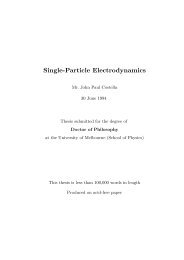HERF Data #3 - Assassination Science
HERF Data #3 - Assassination Science
HERF Data #3 - Assassination Science
You also want an ePaper? Increase the reach of your titles
YUMPU automatically turns print PDFs into web optimized ePapers that Google loves.
PROBABILITY RESULTS<br />
TRANSPORT AIRCRAFT.<br />
Using the flight, emitter, and correlation information just discussed and the probabilities<br />
associated with the fault analysis (tables 1 and 2), expectation values can be obtained for a HIRFinduced<br />
catastrophic aircraft event. For transport category aircraft, these estimates can be made<br />
separately for Denver and Seattle. It is also possible to isolate the probability contributions from<br />
emitters below and above 1 GHz and for average and peak field strengths. Tables 7 and 8 (top<br />
line in each box) summarize these results for transport aircraft.<br />
Imposing the minimum separation distance requirement and the maximum field strength<br />
requirement described above, no flight can exceed the NPRM levels. However, if the minimum<br />
separation distance requirement is not imposed, the italicized values (lower line in each box) in<br />
tables 7 and 8 result. Table 11 reveals that two flights in Denver had separation distances<br />
(ranging from ~ 50-100 ft) less than those limits specified in the NPRM. This can be due either<br />
to errors in the Denver aircraft/emitter information (including radar resolution which is typically<br />
165-330 ft) or to real flight paths occurring very close to emitters. From the information<br />
available, it is impossible to say definitely but an information error is more likely. The<br />
accumulated time above the reference level is 141 seconds for the flight exceeding the allowed<br />
average level and 9 seconds for the flight exceeding the allowed peak level. Even assuming the<br />
worst, the chance of the HIRF certification field levels being exceeded is, at most, on the order of<br />
one in a million.<br />
Imposing the minimum separation distance requirements again, the still relatively high hardness<br />
levels derived from DO-160C, the average field strengths have no problems either below or<br />
above 1 GHz. However, the peak levels above 1 GHz derived from DO-160C exceeded by 17<br />
flights in the Denver sample and by 280 flights in the Seattle sample (table 11). When the other<br />
probability factors are included, expectation values for the HIRF risks for the two cities range<br />
from 0.2e-4 to 5.e-4. Upon closer examination of the Dopler, it was found that four emitters, all<br />
of which were weather or Air Surveillance Radars, were primarily responsible for the<br />
probabilities associated with field strength. There are also four emitters responsible in Seattle,<br />
three radars and a satellite uplink transmitter. In Denver, a single emitter generates the offending<br />
field strengths for approximately 67% of these flights and the average time above the reference<br />
level is less than 50 seconds for all 17 flights. Likewise, in Seattle a single emitter is responsible<br />
for over 90% of the flights having the offending fields strengths and the average time above the<br />
reference level is less than 5 seconds. Removing the NPRM minimum separation distance does<br />
not significantly affect the probabilities associated with the DO-160C-derived field strengths.<br />
By contrast, the much lower levels associated with the older DO-160B are exceeded for both<br />
average and peak field strengths both below and above 1 GHz in both Denver and Seattle.<br />
Moreover, the levels are exceeded on every flight by many emitters (18 to 24 on average),<br />
including television stations. The probability range is 3.e-2 to 4.e-2 for Denver and Seattle.<br />
Removing the NPRM minimum separation distance does not significantly affect the probabilities<br />
associated with the DO-160B-derived field strengths.<br />
11








